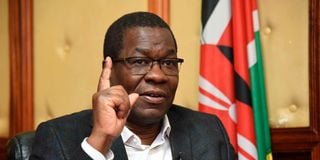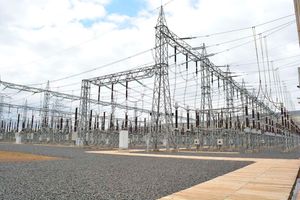Premium
Opiyo Wandayi: I have a duty to explain government interventions in peoples’ lives

Energy and Petroleum Cabinet Secretary Opiyo Wandayi.
Last week, at the opening ceremony of the 4th Edition of the Piny Luo Cultural Festival in Bondo, which was presided over by former Prime Minister Raila Odinga, I took time, in my capacity as Cabinet Secretary for Energy and Petroleum, to explain to the people the various projects the National Government is undertaking in the region regarding access to energy under the last-mile connectivity programme.
I went on to explain in some detail the energy projects the government has initiated in the areas and the monies allocated. I then concluded by disclosing my plans to meet with elected leaders from the four counties that form the Luo Nation to take further stock of the energy sector's operations in the region and discuss ways to improve them.
Since then, independent media pundits and columnists have jumped into this conversation with maximum negativity and strong insinuations.
First, came one Beutta Omanga. Writing in the Standard under the headline “Wandayi playing favourites with our resources”, Omanga claimed that the Kenya Kwanza administration had embarked on a “deliberate focus on pampering Raila Odinga’s backyard with resources,” which will “undoubtedly come at a cost, as other parts of the country look on with growing indignation.”
Omanga claimed that in the past month, President William Ruto had made several trips to Raila Odinga’s stronghold, an unprecedented move that has sparked feelings of jealousy in other regions.
Public resource allocation
Next, Macharia Gaitho, writing in the Daily Nation, warned of the “danger of ethnicisation of resources.” He further cautioned that my pronouncements could be seen as politicisation and ethnicisation of public resource allocation. Gaitho went on to assert that the projects I had enumerated amounted to the use of development funds as “political bribes.”
I want to clarify that I have no regrets whatsoever about explaining to the public the interventions the government is undertaking for their welfare. Furthermore, I disagree with both Mr Omanga and Mr Gaitho that by diverting resources to Nyanza counties, the government is sidelining other regions and politicising public resources.
In this matter, both Omanga and Gaitho are either acting out of ignorance or deliberately distorting facts to achieve undisclosed goals.
As a politician and practitioner of public policy, I know that both resources and government are about people, and people have identities. In Kenya, people identify themselves as Luos, Kikuyu, Luhya, etc.
Therefore, there is no harm in the government explaining to communities the nature and number of resources it has deployed for their welfare.
That is what I have done and continue to do as an obligation in my capacity as a Cabinet Secretary. I explained to the people from the four counties that constitute the Luo Nation, gathered in Bondo, Siaya County, what President Ruto’s government has accomplished for them thus far and its long-term plans regarding energy.
There would be reason for concern if this type of explanation occurred solely in Nyanza and if, as Cabinet Secretary, I exclusively engaged with Luo leaders. However, that is not the case, as every time the President or any of his officials visit a region, they outline what the government has accomplished for the people in that area and what the future holds.
As Cabinet Secretary, I met with elected leaders from various regions on various dates between September and November 2024 in my offices in Nairobi and even in far-flung fields in the countryside.
I met leaders from all the counties in the Coast region on November 28, as well as those from Bungoma (November 25), Marsabit (October 31), and Kakamega (October 29).
I had meetings with the leaders of Bomet on October 16, Tana River and Kajiado separately on October 9, Elgeyo Marakwet on October 3, Meru and Isiolo on October 1, and Nakuru on September 19, to name just a few. In all these meetings, I explained the government’s programmes and budgets for their areas to the elected representatives of the people. No one characterised these as ethnicisation and politicisation of development until Nyanza occurred.
Energy sector
At these meetings, I have made it clear that the government has allocations for every community and region regarding the energy sector.
I have explained to leaders that in the 2023-2024 Financial Year, through the support of development partners and from the government's own revenues, the Ministry of Energy and Petroleum has allocated various amounts of money towards last-mile electricity connections and energy infrastructure projects across all 47 counties. Apart from the Sh1.7 billion, 1.6 billion, 0.9 billion, and 1.2 billion for Homa Bay, Migori, Kisumu, and Siaya, respectively, which I mentioned at the Siaya event, other allocations include Sh0.54 billion (Elgeyo Marakwet), Sh1.5 billion (Nandi), Sh0.8 billion (Trans Nzoia), Sh1.1 billion (Uasin Gishu), Sh0.8 billion (Taita Taveta), and Sh1.29 billion (Bomet), to name just a few.
I have told Mombasa leaders that the government has set aside Sh1.9 billion for energy projects in their region. I have also told the various leaders that Sh2.0 billion is set aside for Tana River, Sh2.1 billion for Kakamega, Sh2.3 billion for Nakuru, Sh0.6 billion for Kajiado, Sh3.4 billion for Marsabit, and Sh2.0 billion for Meru.
I have done this because I believe the public has a right to know what the government is doing, and the government owes it to both itself and the public to explain its actions; otherwise, we create a void that gets filled by naysayers and advocates of negative propaganda.
The writer is the Cabinet Secretary for Energy and Petroleum





